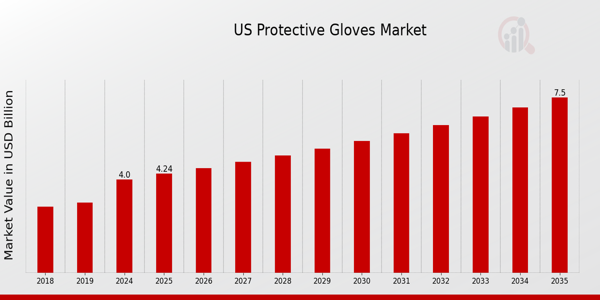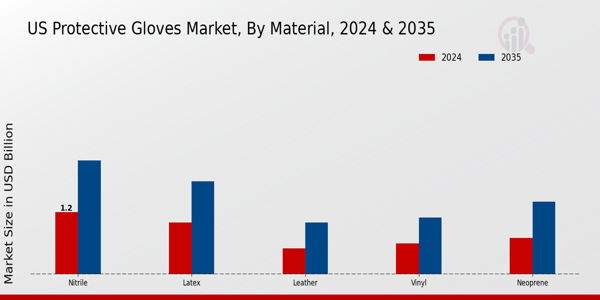US Protective Gloves Market Overview:
As per MRFR analysis, the US Protective Gloves Market Size was estimated at 3.2 (USD Billion) in 2023. The US Protective Gloves Market Industry is expected to grow from 4(USD Billion) in 2024 to 7.5 (USD Billion) by 2035. The US Protective Gloves Market CAGR (growth rate) is expected to be around 5.881% during the forecast period (2025 - 2035).
Key US Protective Gloves Market Trends Highlighted
The US Protective Gloves Market is witnessing significant trends driven by the increasing emphasis on workplace safety and hygiene. The Occupational Safety and Health Administration (OSHA) regulations mandate the use of protective gear in various industries, particularly in healthcare, construction, and manufacturing, which propels the demand for protective gloves. Additionally, the rise in awareness about contamination and infection control, especially in healthcare settings post-pandemic, has led to a substantial increase in the use of disposable gloves. This trend reflects a broader commitment to safety standards that encourage employers to invest in protective gear for their workforce.Amid these developments, opportunities within the US market are emerging as manufacturers innovate to meet changing demands. There is a growing need for specialized gloves that provide enhanced grip, dexterity, and protection against a range of hazards, such as chemicals and biological agents. Moreover, advancements in materials and technology are opening doors for the introduction of eco-friendly and sustainable glove options, aligning with the US consumer's increasing preference for environmentally conscious products. Recent times have seen a shift toward personalization and customization in protective gloves, with many businesses seeking to bolster their brand identity through tailored designs and materials.The rising interest in workplace wellness has led organizations to prioritize ergonomic designs that ensure comfort during prolonged use, ultimately enhancing productivity. As regulations evolve and industries continue to change, the US Protective Gloves Market is likely to adapt, showcasing dynamic responses to these trends and drivers shaping its future landscape.

Source: Primary Research, Secondary Research, MRFR Database and Analyst Review
US Protective Gloves Market Drivers
Increased Healthcare Expenditure
The ongoing rise in healthcare expenditure in the United States significantly propels the US Protective Gloves Market Industry. According to the Centers for Medicare & Medicaid Services (CMS), national health spending in the US is projected to reach over 6.2 trillion USD by 2028, reflecting an average annual growth rate of 5.4%. This increase in healthcare spending emphasizes a greater need for protective equipment, particularly gloves, in hospitals and clinics.Additionally, organizations such as the American Hospital Association are driving initiatives to ensure safety standards, which necessitate a higher utilization of protective gloves. Hospitals also implement protocols that require healthcare professionals to use gloves for various procedures, thereby supporting the overall growth of the market. With the continuous expansion of the healthcare sector, including emerging healthcare facilities, the demand for high-quality protective gloves in the US is expected to soar.
Regulatory Standards and Safety Compliance
Stringent regulatory standards regarding workplace safety, established by the Occupational Safety and Health Administration (OSHA) in the US, significantly influence the US Protective Gloves Market Industry. OSHA mandates that employers provide appropriate personal protective equipment, including gloves, to ensure worker safety, particularly in high-risk industries such as manufacturing, construction, and healthcare. The escalation of compliance requirements has driven organizations to invest in high-quality gloves to meet these regulations.Data indicates that approximately 90% of workplace injuries can be prevented with the use of proper personal protective equipment. Companies like 3M and DuPont have made advancements in protective glove technologies, aiding businesses in adhering to these safety regulations and ultimately enhancing market growth.
Rise in Food Safety and Hygiene Standards
The rising emphasis on food safety and hygiene standards in the US significantly fosters the growth of the US Protective Gloves Market Industry. The US Food and Drug Administration (FDA) enforces stringent regulations regarding food handling and sanitation, requiring food service workers to wear gloves while preparing food. Recent statistics show that foodborne illnesses affect approximately 48 million individuals annually in the US, making adherence to safety standards essential.The National Restaurant Association also highlights the importance of proper hygiene practices in the food industry. Consequently, established companies like Honeywell and Ansell are innovating disposable gloves tailored to the food industry, amplifying the demand and utilization of protective gloves in food service applications.
US Protective Gloves Market Segment Insights:
Protective Gloves Market Material Insights
The US Protective Gloves Market is a vital segment of the personal protective equipment industry, playing a significant role in various sectors such as healthcare, construction, and manufacturing. The market is broadly segmented by material types which include Latex, Nitrile, Neoprene, Leather, Vinyl, and others. Each material serves specific requirements and applications, making them essential in catering to diverse consumer needs. Latex gloves have been traditionally favored in medical settings due to their excellent elasticity and fit, providing dexterity and tactile sensitivity crucial for surgical procedures. However, concerns regarding latex allergies led to the increased adoption of alternatives like Nitrile gloves. Nitrile has gained substantial traction in industries where robustness and chemical resistance are imperative, often being the preferred choice in laboratories and industrial applications. Neoprene, known for its flexibility and durability, is particularly popular in environments requiring resistance to certain chemicals and external elements, making it valuable in sectors such as automotive and manufacturing. Leather gloves are not to be overlooked as they offer substantial protection and are often used in heavy-duty tasks like welding and construction, appreciated for their durability and cut resistance. Vinyl gloves, while primarily associated with non-hazardous tasks, provide a cost-effective option and are widely used in food service and cleaning applications. The other materials category encompasses various innovations, meeting niche requirements in specialized tasks. The changing dynamics of safety regulations and increased focus on worker protection have led to significant opportunities in the US Protective Gloves Market. Growth in awareness about workplace safety has further fueled demand across various applications, signaling a pivotal shift towards incorporating advanced protective gear. The trends indicate a flourishing market that is poised to adapt with new innovations in materials, reflecting the ongoing need to enhance safety and performance standards across industries. Furthermore, sustainability concerns are gradually influencing material choices, as manufacturers explore eco-friendly options and biodegradable materials to minimize environmental impact. With regulatory pressures on safety standards intensifying, the material segment within the US Protective Gloves Market will likely continue to evolve, driven by innovation and consumer demand for improved protective solutions.

Source: Primary Research, Secondary Research, MRFR Database and Analyst Review
Protective Gloves Market Type Insights
The US Protective Gloves Market demonstrates a diverse segmentation by Type, predominantly categorized into Re-usable and Disposable gloves. Re-usable gloves are critical in numerous industries, including healthcare and manufacturing, as they offer durability and long-term cost efficiency. This segment is significant due to its environmental advantages, as it reduces waste associated with single-use products. On the other hand, Disposable gloves play a vital role in maintaining hygiene standards across food service and medical sectors. With increasing compliance regulations and awareness of safety protocols, the demand for Disposable gloves is consistently high, making this category a major contributor to the market.As awareness around workplace safety continues to grow, both segments are projected to influence market growth positively. The trends indicate a shift towards highly specialized gloves with advanced materials that enhance protection while ensuring comfort. Overall, the US Protective Gloves Market segmentation reflects an adaptation to evolving consumer needs and safety regulations, symbolizing a crucial component of health and safety practices across various sectors.
Protective Gloves Market Application Insights
The US Protective Gloves Market encompasses diverse applications across various sectors, reflecting the growing demand for hand safety and protection. This market consists of several segments, including Chemical, Mechanical, Biological, Thermal, and Others. Each segment plays a critical role in enhancing workplace safety, as industries like manufacturing, healthcare, and construction increasingly prioritize protective measures. The Chemical application is imperative due to the hazards posed by toxic substances, greatly influencing regulations and standards for workplace safety.Meanwhile, the Mechanical segment focuses on protecting against physical hazards, which is essential in industries such as automotive and construction, where risk exposure is significant. The Biological application is vital for sectors like healthcare, where the threat of infections and contamination is prevalent. Thermal gloves offer protection against extreme temperatures, making them crucial for industries involving heat exposure. The Others segment captures specialized needs that arise across various industries, demonstrating the versatility of protective gloves.As awareness of safety standards rises, the demand in these segments is expected to increase, promoting the significance of advancements in materials and protective technologies. The US Protective Gloves Market statistics confirm a trend toward more specialized and high-performance gloves, responding to the diverse challenges faced by different sectors.
Protective Gloves Market End-use Industry Insights
The US Protective Gloves Market is witnessing significant growth driven by various end-use industries that highlight the necessity and expansion of glove utilization across diverse sectors. In the healthcare sector, there is an increasing demand due to strict hygiene standards and the rise of infectious diseases, making protective gloves a vital component in medical settings. In manufacturing, gloves serve as essential safety gear to protect workers from various hazards, reflecting a growing emphasis on workplace safety regulations. The food and beverage industry also plays a critical role, as gloves are paramount for maintaining sanitation during food handling and preparation processes, addressing both consumer health and food safety laws.The oil and gas sector underscores the need for durable protective gear to ensure employee safety in hazardous environments. Construction and transportation industries further reinforce the market's robustness, as gloves are indispensable for protecting workers from physical injuries and ensuring operational efficiency. Other sectors are also emerging, showcasing an evolving landscape in which protective gloves are increasingly recognized for their importance in maintaining safety standards across diverse operational settings, paving the way for continued market growth.
US Protective Gloves Market Key Players and Competitive Insights:
The US Protective Gloves Market is characterized by a dynamic and competitive landscape, driven by the growing concerns for safety and hygiene across various industries. This market is influenced by factors such as increased workplace safety regulations, heightened awareness regarding personal protective equipment, and the rising demand for gloves due to health and safety protocols. Within this segment, manufacturers are constantly innovating their product lines to cater to diverse industrial needs, encompassing various levels of protection, comfort, and functionality. The market is marked by the presence of established brands and emerging players, leading to a competitive environment where companies strive to gain market share through strategic initiatives and product differentiation. Understanding these competitive insights is key for stakeholders looking to navigate the complexities of the US Protective Gloves Market effectively.Showa Group has carved a significant niche in the US Protective Gloves Market, establishing a strong foothold with its innovative and technologically advanced products. The company is well-regarded for its commitment to quality, sustainability, and performance, which resonates with a broad customer base in the region. With a diverse product portfolio that meets rigorous safety standards, Showa Group has gained a reputation for providing high-performance gloves designed for various applications, including industrial, healthcare, and consumer use. Its strengths lie in its robust research and development capabilities, enabling the company to continually refine and develop new glove technologies that enhance user safety and comfort. Additionally, Showa Group's proactive approach in addressing market demands enables it to respond quickly to shifts in consumer preferences and regulatory requirements, consolidating its position within the competitive landscape.Cawood operates with a strong presence in the US Protective Gloves Market, focusing on providing a wide range of protective glove solutions that cater to various industries such as construction, manufacturing, and healthcare. The company is renowned for its commitment to delivering quality products that prioritize user safety and comfort. Key offerings from Cawood include industrial gloves that are designed for durability and resilience, ensuring they meet the demands of rigorous applications. Cawood has strengthened its market presence through strategic partnerships, enhancing its distribution network and expanding its reach within the US. Furthermore, the company has been involved in mergers and acquisitions, enabling it to integrate innovative technologies and expand its product line. Cawood’s strengths in market responsiveness and customer service have contributed to building a loyal client base, positioning it as a reliable player in the competitive landscape of protective gloves in the United States.
Key Companies in the US Protective Gloves Market Include:
Showa Group
Cawood
Superior Glove Works
Protech Engineering
KimberlyClark
Global Glove and Safety Manufacturing
DuPont
Carolina Glove Company
MCR Safety
Aurelia Gloves
3M
Honeywell
Ansell
AMMEX
US Protective Gloves Market Industry Developments
Recent developments in the US Protective Gloves Market reveal significant advancements and activities among major players. Companies such as Showa Group, Cawood, Superior Glove Works, and Protech Engineering have been reinforcing their positions through innovation and expansion. For instance, Kimberly-Clark and DuPont are enhancing their product lines to meet the growing demand for personal protective equipment, particularly in healthcare and industrial sectors. Additionally, mergers and acquisitions have shaped the landscape; notably, in August 2023, Honeywell announced its acquisition of a safety equipment manufacturer to enhance its portfolio, corroborating the trend towards consolidation within the market. Furthermore, the overall market valuation for protective gloves has witnessed notable growth, spurred by heightened awareness surrounding occupational safety and public health concerns. The market has expanded dramatically in the last couple of years, especially following the pandemic, with major reports indicating that the industry's revenue reached unprecedented levels in 2022. With increasing regulatory requirements and a focus on worker safety, the demand for high-quality protective gloves continues to rise, driving the market forward in the United States.
US Protective Gloves Market Segmentation Insights
Protective Gloves Market Material Outlook
Latex
Nitrile
Neoprene
Leather
Vinyl
Others
Protective Gloves Market Type Outlook
Re-usable
Disposable
Protective Gloves Market Application Outlook
Chemical
Mechanical
Biological
Thermal
Others
Protective Gloves Market End-use Industry Outlook
Healthcare
Manufacturing
Food & Beverage
Oil & Gas
Construction
Transportation
Others
Report Scope:
| Report Attribute/Metric Source: |
Details |
| MARKET SIZE 2018 |
3.2(USD Billion) |
| MARKET SIZE 2024 |
4.0(USD Billion) |
| MARKET SIZE 2035 |
7.5(USD Billion) |
| COMPOUND ANNUAL GROWTH RATE (CAGR) |
5.881% (2025 - 2035) |
| REPORT COVERAGE |
Revenue Forecast, Competitive Landscape, Growth Factors, and Trends |
| BASE YEAR |
2024 |
| MARKET FORECAST PERIOD |
2025 - 2035 |
| HISTORICAL DATA |
2019 - 2024 |
| MARKET FORECAST UNITS |
USD Billion |
| KEY COMPANIES PROFILED |
Showa Group, Cawood, Superior Glove Works, Protech Engineering, KimberlyClark, Global Glove and Safety Manufacturing, DuPont, Carolina Glove Company, MCR Safety, Aurelia Gloves, 3M, Honeywell, Ansell, AMMEX |
| SEGMENTS COVERED |
Material, Type, Application, End-use Industry |
| KEY MARKET OPPORTUNITIES |
Increased industrial safety regulations, Rising healthcare sector demand, Growth in e-commerce packaging, Advancements in glove materials, Expansion of eco-friendly options |
| KEY MARKET DYNAMICS |
growing safety regulations, increasing healthcare demand, rising industrial accidents, environmental sustainability trends, technological advancements in materials |
| COUNTRIES COVERED |
US |
Frequently Asked Questions (FAQ) :
The US Protective Gloves Market is expected to be valued at 4.0 billion USD in 2024.
By 2035, the US Protective Gloves Market is expected to reach a value of 7.5 billion USD.
The projected CAGR for the US Protective Gloves Market from 2025 to 2035 is 5.881 percent.
The nitrile material segment holds the largest market share, valued at 1.2 billion USD in 2024.
The latex segment is expected to be valued at 1.8 billion USD in 2035.
Key players in the market include Showa Group, Kimberly-Clark, 3M, and Ansell among others.
The market presents growth opportunities driven by increasing demand for safety in various industries.
The neoprene segment is expected to be valued at 0.7 billion USD in 2024.
Challenges in the market include competition and fluctuating raw material prices.
The heightened focus on safety regulations and workplace protection is expected to significantly boost market growth.
















